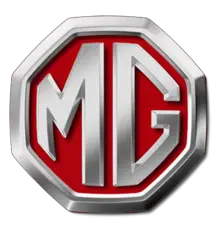
The MG logo has had many evolutionary stages, and the evolution of the MG logo has spanned more than a century. The first MG cars had logos that were inspired by the original Morris Garages emblem, which was derived from the coat of arms of its founder. It featured two chevrons side-by-side with a crown sitting atop them. This first emblem’s similarity to the Morris Garages emblem was probably why it was replaced with an emblem that had nothing at all to do with Morris Garages or their coat of arms.
Early in 1926, Morris Garages adopted its new badge, which is considered by motorsport historians as the first ever racing car badge. Its design consisted of five shields each bearing one arrowhead. A top bar with the words ‘The Morris Garages’ ran across the shield. This MG emblem became known by its more common name of “The Rooster”. The original racing car badges consisted of only two chevrons, but it was later amended to three chevrons after a boardroom meeting.
MG Car Co. Ltd. also began using the new racing car emblem at the same time, but it did not replace their original MG logo. Instead they used both logos side by side for some years. The new MG badge would continue to be used until 1963 when it was disposed of in favor of a “transition” logo that was used between 1966 and 1968.
The MG logo was revived in 1968, when it was used to adorn the front grill of the MGC. Some years earlier, in 1961, this same emblem had been put on the bonnet of a special MG TF named ‘Le Mans’. This car had been made famous by its stunning performance at the famous Le Mans circuit, where it had finished 13th overall. The racing car logo was also used in the MG MGB GT V8, which was produced between 1991 and 1993.
Despite the demise of MG Car Company in 1980, British Motor Heritage continued to use the classic Rooster badge on a range of cars up until 1985, when it was replaced with a rather garish emblem that was derived from the BMC logo. This trademark only survived a few years before being replaced by a more classic looking shield-style logo in 1988, which is still in use today. The modern MG car company has no direct connection to Morris Garages or its staff.
The idea of reviving the MG marque was conceived by the car dealer Peter Sheppard. He wanted to create a new series of cars that would be positioned between those offered by traditional British sports car manufacturers and mass production automobile companies such as Ford and Vauxhall.The original MG logo was revived with this new brand, complete with its proud rooster emblem. The first model produced under the resurrected MG brand was the MG F, which had been launched in 1991.
Today, this is one of the most successful cars that MG has ever produced. This emblem continued to be used by British Motor Heritage up until 2002 when it decided to revive its old racing car badge once again. From 2003 onwards, the brand new MG sports car were adorned with the racing car logo instead of the Rooster emblem. This classic symbol made its debut at the British International Motor Show in 2003, which was held at the NEC in Birmingham.
The MG sports cars manufactured between 2003 and 2012 were all fitted with this badge, but it was only used on some other models up until 2010. The modern day MG sports car are all fitted with logos that look like the old racing MG emblem. This fact has provided many enthusiasts with hope that the Rooster emblems of old will be brought back into production soon.
The traditional swallow logo is still used by Labrooy Design, a British company that designs and builds luxury sports cars for other companies around the world, including Jaguar and Bentley. The last time this MG logo was used in a production car was way back in 1991 when it adorned the bonnet of a special edition MGB GT named ‘Le Mans’. Back then, around 1600 units were built as part of an ambitious plan to enter the GT endurance racing circuit. However, those plans never came to fruition due to financial constraints.